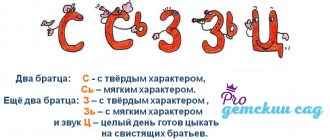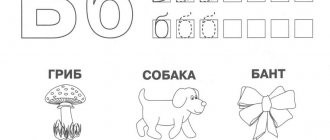Pronunciation of the T sound
We can highlight common mistakes made in the pronunciation of the T sound:
- replacing the sound T (it is front-lingual) with G and K (they are called back-lingual);
- mixing or rearranging consonants located next to the sound T (“rolled” instead of “glass”);
- after P or K, the T sound is lost and replaced with a softening (“piichka” instead of “birdie”);
- replacing the sounds Ch and C with T (“nine” instead of “girl”, “Petsya” instead of “Petya”).
Children who replace the T sound with some other sound often have incorrect articulation. The child raises his tongue to the palate, while the tip of the tongue should rest against the front teeth.
The reasons for incorrect pronunciation are as follows:
- malfunctions of the articulatory apparatus (speech organs);
- the lower jaw is weakly developed, which is why it is inactive during speech;
- the hearing organs are poorly developed, which is why the child cannot distinguish sounds by ear;
- imitating an adult who has problems with correct pronunciation.
Only a speech therapist can make a diagnosis. And parents, in turn, can practice at home the exercises recommended by a professional.
Making the sound "s"
The sound “s” in dysarthria is practiced depending on the complexity of the patient’s speech disorder. In difficult cases, when the patient has impaired hearing and speech, the production of the sound “s” can be done in several ways, with preliminary practice of the sounds “f”, “fa”. The speech therapist teaches the patient how to hold the tongue correctly when exhaling and at the same time pronounce a sound. When making a sound, a special thin blade is used, which is used to lightly press the tongue while exhaling and practicing the sound. This is how you can produce whistling sounds for dysarthria (anterior lingual teeth, fricative “z” and “s”). Whistling sounds are formed by a stream of air passing through the organs of speech and resembling a whistle.
When whistling sounds are produced, the air stream passes through a narrow gap that forms between the front of the tongue and the hard palate. The reference sound for the production of “s” is the sound “i”. Therefore, classes include pronunciation of the sound “i”. The doctor suggests hiding your tongue behind your teeth and smiling broadly to say “i-i-i.” Then the doctor and the patient pronounce words containing the sound “and”, the speech therapist uses various exercises. The production of the sound “s” begins after carrying out exercises with the sound “i” in various ways. Having clenched your teeth and smiling, you should silently say the sound “and”, then imagine that you are blowing on the ball. The lips should not close; the tip of the tongue should be behind the lower teeth. During the exercise, the sound “s” is heard.
The second method is performed with the help of a mechanical assistant. The tip of the tongue is located behind the lower teeth, the teeth are exposed in a smile, a thin stick is placed on the tip of the tongue, lightly pressing the tongue. The stick forms a groove in the center of the tongue. The doctor invites the patient to blow on the tip of the tongue with a strong air stream. The sound "s" is heard. In order for the exercise to be successful, you should bring the back of your hand to your mouth and watch the air stream - it should be cool and narrow. When the patient begins to pronounce the sound well, they move on to automating the sound in sentences and words.
Articulatory gymnastics for the sound t
It is necessary to do articulation exercises daily. Get used to the fact that in any free time you and your baby develop the speech apparatus.
Setting the T sound
- Choose several syllables or words that contain the letter combination TA, and repeat them at least 10 times.
- Place the tongue between the teeth and press it firmly, but at the same time so that it does not hurt the baby, with the jaw. Take a deep breath and, as you exhale, say an interdental T.
- Place your tongue between your teeth again. Stretch your teeth in a smile and “spit.” After this, give your jaw a rest.
- T is a derivative sound from P. Therefore, you can start warming up by practicing the sound P. Say Pa-Pa several times, while the wide part of the tongue should be pressed to the lower lip. Gradually stretch your lips into a smile and move on to pronouncing Ta-Ta.
- Place the tongue between the teeth. Say Pa-Pa again several times. At this moment, the adult spreads the child’s lips with his index finger and thumb. When the manipulation is performed correctly, Ta-Ta is pronounced.
Sound production
- Talk to the child Ta-Ta.
- A special paddle is used to soften the sound. Use it to press the tip of your tongue and lower it down. You should get the letter combination Tya.
- The sound Th is produced by clicking the tip of the tongue; the teeth should be closed at this time.
- You can complicate the exercise: do not press your tongue against the palate, but stick it out.
Gymnastics for setting the sound T
Setting the T sound
There are several methods:
- You need to choose several words or syllables with a combination of TA sounds, repeating them, the child trains the production of T.
- Starting position - the tongue is between the teeth and pressed tightly by the jaws on both sides. Then take a deep breath. After obtaining the interdental T, it is retracted.
- The starting position is the tongue between the teeth. Next, open your teeth slightly in a smile and “spit” slightly.
- T is trained as a derivative sound from P. Start with several repetitions of PA - PA, placing the tip of the tongue in its widest place against the lower lip. Then you need to repeat the original sounds in a smile, and TA - TA should sound.
- Interdental position of the tip, again training from P. You need to repeat PA - PA several times, at this time you need to separate your lips with your thumb and forefinger. If everything is done correctly, it should sound TA - TA.
Setting the sound TH
Methods:
- First, the child pronounces a slightly different combination of sounds - TA.
- To soften a hard syllable, you need to lightly press and lower the tip of your tongue with a special spatula, you should get the sound TY.
- The sound Т is produced by clicking the tip of the tongue behind closed teeth.
- During the click, a soft clicking sound is produced (children make a similar sound after tasting delicious food), the sound should be close to T. With practice, it can be improved if you do not press the tongue against the palate, but try to “blow” it out.
Speech therapy exercises
It is necessary to work on overall articulation and clarity of speech. For this, simple and interesting speech therapy complexes are used. We present one of these to your attention.
- “Brushing our teeth.” Stretch your lips in a smile, mouth slightly open. Use your tongue to walk alternately over the upper and lower teeth from the back side. Move from left to right and then in the opposite direction.
- "Spatula". Smile again with your mouth slightly open. Place the wide part of your tongue on your lower lip. Stay in this position for 10 seconds. You can start with 5 seconds.
- “Tube”. Extend your tongue as much as possible and tense it. Then, if possible, roll it up into a tube and stay in this position for 5-10 seconds.
- "Swing". Open your mouth slightly and press the wide part of your tongue against your lower teeth. Then raise your tongue to your upper teeth. We linger in each position for 2-3 seconds. In this case, you need to press with maximum force.
- "Slide". Starting position – mouth slightly open. Press the tip of your tongue firmly against the bottom row of teeth. Then, without lifting the tip, press with the wide part of your tongue (it should bend as if). Stay in this position for 5 seconds.
- "Mountain Wind" Place your tongue in the position described in the previous exercise and blow as hard as possible. In this case, the entire speech apparatus should be tense.
Game exercises
Playful exercises will help maintain interest:
- “Brushing our teeth.” When a child smiles, he slightly opens his teeth, opens his mouth slightly, and with the tip of his tongue passes first over the upper teeth, then over the lower teeth from the back, moving left and right.
- "Spatula". You need to smile, open your mouth slightly, and place the wide part of the front edge of your tongue on your lower lip. This position is maintained while the adult counts from 1 to 10. You can start with 5 seconds, then gradually increase the time to 10 seconds.
- "Tube". First, you need to stick your tongue out of your open mouth and stretch it out as much as possible. Then, narrowing it, tighten it. The position is maintained for about 10 seconds.
- "Let's swing on the swing." When you smile, you need to open your mouth slightly and lean the tip of your tongue (in its widest part) against the lower dentition. At first it is located behind the lower teeth, then moves behind the upper teeth. The up and down positions change several times.
- "Slide". Again, the starting position is the mouth slightly open in a smile, the tip of the tongue leaning against the bottom row of teeth. Then it bends in an arc, tightly touching the lower teeth.
- "Mountain Wind" The child smiles with his mouth slightly open. While the tongue is arched, slowly, you need to gently blow into its center. The air flow should be cold.
There is no need to rush and put pressure on the child, you need to practice every day and the result will definitely come, for some children earlier, for others later. Patience, and more patience! The main thing is to carefully monitor the technique of performing articulation gymnastics, listen to the individual needs and characteristics of the child.
Setting the sound t when replacing with k
- First you need to teach your baby to distinguish between these two sounds. To do this, you can give pictures, the images in which begin with the sounds T or K, and also pronounce such words out loud. Ask the child to distribute into groups (K and T).
- Game “Catch the Sound”. The adult pronounces a small series of letter combinations, and the child must clap his hands when he hears the given sound.
- We are looking for the sound K. Dar-ra-ko-so. Sa-lo-ku-we. Am-da-ka-he ku-ro-lo-ky
- We are looking for the sound T. Ba-ta-do. Na-la-to. Ash-bo-ot. Ju-fu-fu.
Making the sound "th"
The sound “th” refers to the middle lingual, oral, fricative, consonant, voiced, soft sounds. Before setting the sound “th”, speech therapy gymnastics is carried out, then the sound is set by imitation, which is accompanied by tactile sensations and demonstration of articulation. Sound production can be done by pronouncing the sound combinations “ya” at a fast pace, using the sound “z”, pressing the tip of the child’s tongue when pronouncing the sound - the sound “th” is obtained. The sound “th” is heard when the sound “h” is pronounced.
Setting the t sound for dysarthria
At the very beginning, you need to pay attention to warming up the tongue and removing tone, as well as general gymnastics for the speech apparatus. For this purpose, the speech therapy exercises listed above are used.
- Raise and lower your tongue, turn right and left. In this case, the tongue is extended as much as possible.
- Then the adult invites the child to tap his tongue on the upper palate (the sound should be T).
- To obtain a soft consonant, the tongue is pressed harder against the palate and moves out more between the teeth. At the same time, the passage for air is reduced.
- To practice the T sound, it is pronounced between two vowels (at least 10 repetitions).
- The baby must cluck at least 20 times. After this, the task becomes more complicated: you need to click while exhaling, not while inhaling.
- The child is asked to place his palm on his larynx. After this, pronounce the sounds T and D. Focus on the difference in vibrations during the pronunciation of the sounds T and D.
Making sounds T - D
Topic: Production of sounds T - D when replaced with back-lingual K G
Speech therapist teacher: Yalovaya E.A.
MAOU "Career Planning" Tomsk
Our speech consists of sounds. A child must learn to correctly pronounce the sounds of his native language before school. In preschool age, the child’s pronunciation of sounds is observed incorrectly. This is a completely natural phenomenon. Three- to four-year-old children are characterized by a general immaturity of language. If you are not attentive to the child’s sound pronunciation, then such substitutions and distortions of sounds can remain for a long time.
For successful learning, a child needs intelligible and clear sound pronunciation. However, a large number of first-graders come to school with impaired or distorted pronunciation of sounds.
Experts note that recently a new type of dyslalia has appeared - incorrect pronunciation of sounds T - D. These anterior lingual sounds appear in ontogenesis at the age of 3 - 4 years.
Children make typical mistakes
:
- Replacing the sounds of the front lingual “T – D” with the corresponding back lingual “K – G”, for example, “fuk(T
)bolka", "shk(t)any".
- Mixing the front-lingual consonants “T – D” with the back-lingual “K – G”: cell - cell; glass - rolled.
- The sound “T” can be softened by “P” or “K”, for example: pichka - bird; drink, drink instead of dot.
Reasons for incorrect sound pronunciation
:
- Insufficient development of the articulatory apparatus.
- Violation of muscle tone of articulatory muscles.
- Underdevelopment of auditory perception (difficulty in differentiating sounds).
Articulation pattern of the T sound
.
The sound T is front-lingual, consonant, hard, deaf. The sound D is anterior lingual, consonant, hard, voiced.
- The lips in a neutral position take the position of the next vowel sound,
- The distance between the teeth is 5 mm.
- When pronouncing the vowel sounds A, O, U, Y, the tip of the tongue rests on the upper teeth or alveoli and forms a stop.
- The soft palate is raised, the vocal folds are open, the air stream is jerky
Features of sound production T - D
The classic techniques of speech therapy work are the preparatory stage and sound production.
1.Preparatory stage
Articulation gymnastics.
Speech therapy massage will help prepare the speech apparatus for it.
- “Wide smile” – connect your teeth, stretch your lips wide and hold this position for up to 7 seconds
- “Naughty Tongue” - say five-five-five, tapping your upper lip on your tongue, gradually differentiating (distinguishing) the sounds P-T.
- “Pancake” - relax the tongue, making it wide, and place it on the relaxed lower lip.
- “Rock” - raise the tongue only to the upper lip. We increase the lift of the tongue.
- “Grandfather’s mustache” - hold the cotton swab with your tongue on (above) your upper lip.
- “Sail” - a narrow tongue rests on the upper teeth - mast, raise the sail - a wide tongue. Alternation of narrow and wide language.
Exercise to form correct directed exhalation
- Blow out the candle - the child must purse his lips into a tube and sharply blow on the candle flame and extinguish it.
- Let's kick the ball into the goal. The child makes a gate out of cube bricks, places them in front of him, rolls a ball out of cotton wool and, smiling, blows hard on the ball, trying to get into the gate.
- “Snowflake” - the cotton wool is placed over the upper lip, the tongue covers the upper lip - inhale and exhale on the cotton wool.
Breathing exercise “Snowflake”. Exercises for the tongue “Grandfather’s mustache”, “Rock”, “Sail” are quite effective in cases where the child has increased muscle tone of the tongue and he cannot hold it near the teeth when exhaling.
2. Setting the sound T.
- Demonstration of correct lip and tongue position by showing
distinctions in pronunciation, for example, T
(tip of the tongue) and
K
(tail of the tongue): “The cake is being eaten,” “Drops are dripping.”
- Imitation setting: an adult shows the position of the tongue and suggests repeating first the syllables and then the words.
- Interdental. The speech therapist asks the child to smile, bite the tip of his tongue with his teeth, and forcefully, sharply push the air forward. In this case, you can control the exhalation with your hand or blow on a cotton ball.
- Staging T
from the
sound
P. The child repeats pa-pa-pa, placing the wide tip of the tongue on the lower lip, then, smiling broadly, pronounces P
, resulting
in T. - Staging from C
.
I propose this technique from the opposite: the sound C “hides” two sounds behind it - s-t
.
“The cat catches the mouse” - we invite the child to imitate the movement of the cat’s claws with his fingers, straining his fingers and saying: tsap, tsap, tsap.
Then we shorten the syllable - tsa, tsa, tsa.
And here we are near the mink - we say Ts, Ts, Ts more and more quietly. Here you need to ask the child to only hit the teeth with the tongue - the T sound, do not pronounce the C sound.
- When setting D
Identical work is carried out, only when exhaling the voice is added.
Automation of sounds T D
The sound is on. The beginning of a new stage: automation. All work on automation and differentiation of the studied sound consists of developing the skills of recognition and correct pronunciation of sound in syllables, words and sentences. It is important to achieve free pronunciation, while not forgetting about articulatory gymnastics.
The correct selection of articulatory and breathing exercises, exercises, and verbal material will help to obtain good results in the development of competent, beautiful speech in a child.
This is a long, labor-intensive process that requires patience and hard training. With systematic and regular work on the sounds T and D, it is possible to achieve positive results, i.e. create sounds, automate them and introduce them into the child’s speech.
3
Setting the sound "ts"
The sound “ts” is introduced after the child begins to pronounce the sounds “s” and “t” well. With the rapid repetition and merging of the sounds “t-s”, the sound “ts” is obtained. The sound of the sound “ts” can be achieved by imitation. The child’s palm is brought to the speech therapist’s mouth, the sound “ts” is pronounced with a strong exhalation - the child feels a stream of cold air on his palm. The doctor shows the child the position of the tongue, lips and teeth when pronouncing a sound. Then the child must repeat several times the syllables consisting of the sound combination “ts” and vowels.
When pronouncing a sound, the tip of the tongue rests on the front teeth, the tongue is curved and raised, the lateral edges of the organ are tense. When pronouncing a sound, the tip of the tongue moves away from the front teeth, increasing the flow of air. The part of the tongue adjacent to the palate is lowered. When pronouncing, the teeth are brought together, the lips are stretched into a smile. The air comes out with a push when the palate and tongue open; the palm applied to the mouth feels a strong and cold stream. To consolidate the result, the doctor pronounces tongue twisters with the child and plays games to identify the sound “ts” with his eyes closed.
In case of interdental sigmatism, for good pronunciation of the sound, a spatula or a teaspoon is used, which is used to fix the tip of the tongue on the inside of the lower teeth while pronouncing the sound. The middle part of the tongue should connect to the hard palate. With labiodental sigmatism, the lower lip interferes with the pronunciation of sounds. To ensure the purity of sound pronunciation, the doctor holds the child’s lower lip while the child learns to pronounce forward and backward syllables containing the sound “ts”. The production of the sound “ts” is carried out through daily activities with the child, through games, and pronouncing tongue twisters.








